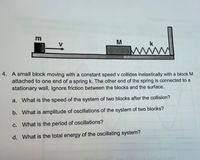
College Physics
11th Edition
ISBN: 9781305952300
Author: Raymond A. Serway, Chris Vuille
Publisher: Cengage Learning
expand_more
expand_more
format_list_bulleted
Concept explainers
Topic Video
Question

Transcribed Image Text:M
k
4. A small block moving with a constant speed v collides inelastically with a block M
attached to one end of a spring k. The other end of the spring is connected to a
stationary wall. Ignore friction between the blocks and the surface.
a. What is the speed of the system of two blocks after the collision?
b. What is amplitude of oscillations of the system of two blocks?
c. What is the period of oscillations?
d. What is the total energy of the oscillating system?
Expert Solution
This question has been solved!
Explore an expertly crafted, step-by-step solution for a thorough understanding of key concepts.
This is a popular solution
Trending nowThis is a popular solution!
Step by stepSolved in 2 steps with 2 images

Knowledge Booster
Learn more about
Need a deep-dive on the concept behind this application? Look no further. Learn more about this topic, physics and related others by exploring similar questions and additional content below.Similar questions
- A spring with spring constant 18.0 N/m hangs from the ceiling. A 510 g ball is attached to the spring and allowed to come to rest. It is then pulled down 7.80 cm and released. Part A What is the time constant if the ball's amplitude has decreased to 2.60 cm after 53.0 oscillations? Express your answer with the appropriate units. HA Value Unitsarrow_forwardProblem 9: A 12.0-g bullet is fired into a block of wood (at rest) with some initial speed. The block is attached to a spring that has a spring constant of 200 N/m and rests on a frictionless floor. The block with the embedded bullet oscillates at a frequency of f= 2.8 Hz and compresses a maximum distance of d = 0.51 m. What was the initial speed of the bullet? darrow_forwardB5arrow_forward
- 1: In this question we will study the damped harmonic oscillator. Consider the following spring-mass system. kr bà Figure 1: Spring-mass system with a friction force. That is, an object of mass m is attached at the end of a spring with spring-constant k. We will also consider the effect of friction. Friction works in the opposite direction of motion, as illustrated in the figure. A) Show that the differential equation governing the damped spring-mass system is: më = -bå – kx (1) dr and i = dt where i = dt2 b) To solve the differential equation (1), we will take the following ansatz: r(t) = Ae. (2) If the above r(t) is a solution of Eq. (1) show that A has to satisfy the following equation: 1² +27d + wi = 0, (3) * and wi = k Solve the above equation to find A. m2 b where y 3= 2m c) For wi >?, show that the general solution can be written as: x(a) = Ae-t cos (wt +0) (4) where w? = w - 7². 2: Using Fermat's principle prove the law of reflection and the law of refraction of light.arrow_forwardA 500g block connected to a spring which the force constant is 5 N/m is free to oscillate on a frictionless, horizontal surface. The block is displaced 6cm from equilibrium and released from rest. Calculate the following: a.Period ofthe motion in seconds b.Maximum speed in m/s. c.Maximum acceleration in m/s2 d.Express the position, velocity, and acceleration as functions of time.arrow_forwardA mass weighing 4 Ibs. stretches a spring 6 in. If the mass is pushed upward, contracting the spring distance 1 in and then set in motion with a downward velocity of 2 fl/s, and if there is no damping. a. Find the position function u of the mass at any time t. b. Determine the frequency, period, amplitude, and phase of the motion.arrow_forward
arrow_back_ios
arrow_forward_ios
Recommended textbooks for you
 College PhysicsPhysicsISBN:9781305952300Author:Raymond A. Serway, Chris VuillePublisher:Cengage Learning
College PhysicsPhysicsISBN:9781305952300Author:Raymond A. Serway, Chris VuillePublisher:Cengage Learning University Physics (14th Edition)PhysicsISBN:9780133969290Author:Hugh D. Young, Roger A. FreedmanPublisher:PEARSON
University Physics (14th Edition)PhysicsISBN:9780133969290Author:Hugh D. Young, Roger A. FreedmanPublisher:PEARSON Introduction To Quantum MechanicsPhysicsISBN:9781107189638Author:Griffiths, David J., Schroeter, Darrell F.Publisher:Cambridge University Press
Introduction To Quantum MechanicsPhysicsISBN:9781107189638Author:Griffiths, David J., Schroeter, Darrell F.Publisher:Cambridge University Press Physics for Scientists and EngineersPhysicsISBN:9781337553278Author:Raymond A. Serway, John W. JewettPublisher:Cengage Learning
Physics for Scientists and EngineersPhysicsISBN:9781337553278Author:Raymond A. Serway, John W. JewettPublisher:Cengage Learning Lecture- Tutorials for Introductory AstronomyPhysicsISBN:9780321820464Author:Edward E. Prather, Tim P. Slater, Jeff P. Adams, Gina BrissendenPublisher:Addison-Wesley
Lecture- Tutorials for Introductory AstronomyPhysicsISBN:9780321820464Author:Edward E. Prather, Tim P. Slater, Jeff P. Adams, Gina BrissendenPublisher:Addison-Wesley College Physics: A Strategic Approach (4th Editio...PhysicsISBN:9780134609034Author:Randall D. Knight (Professor Emeritus), Brian Jones, Stuart FieldPublisher:PEARSON
College Physics: A Strategic Approach (4th Editio...PhysicsISBN:9780134609034Author:Randall D. Knight (Professor Emeritus), Brian Jones, Stuart FieldPublisher:PEARSON

College Physics
Physics
ISBN:9781305952300
Author:Raymond A. Serway, Chris Vuille
Publisher:Cengage Learning

University Physics (14th Edition)
Physics
ISBN:9780133969290
Author:Hugh D. Young, Roger A. Freedman
Publisher:PEARSON

Introduction To Quantum Mechanics
Physics
ISBN:9781107189638
Author:Griffiths, David J., Schroeter, Darrell F.
Publisher:Cambridge University Press

Physics for Scientists and Engineers
Physics
ISBN:9781337553278
Author:Raymond A. Serway, John W. Jewett
Publisher:Cengage Learning

Lecture- Tutorials for Introductory Astronomy
Physics
ISBN:9780321820464
Author:Edward E. Prather, Tim P. Slater, Jeff P. Adams, Gina Brissenden
Publisher:Addison-Wesley

College Physics: A Strategic Approach (4th Editio...
Physics
ISBN:9780134609034
Author:Randall D. Knight (Professor Emeritus), Brian Jones, Stuart Field
Publisher:PEARSON